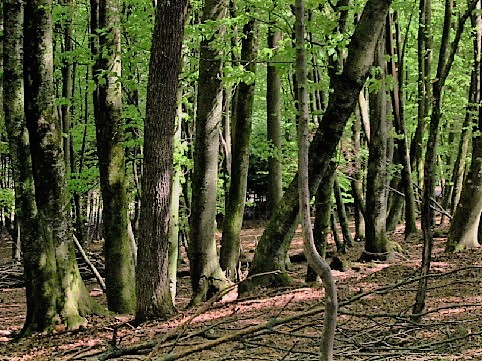Consumerism,
Society — by
Zaia Kendall February 21, 2012
http://permaculture.org.au/2012/02/21/the-time-for-change-is-now/
What is happening in the world today and how can people help themselves, each other and the planet, so that the future will look bright again.
by
Zaia Kendall

I would like to start off by saying how much I love Australia. The people are great, there is a lot of opportunity here for everyone and we have a lot of space and an enormous amount of wealth.
Unfortunately, this also means that people become complacent.
I was born and grew up in Europe and still have family living there. Things are tough in Europe at the moment. Pensions are being cut or will in the near future, people have trouble meeting their expenses (and there are a lot of those in Europe…) and there is a lot of unrest everywhere due to financial instability. Things have started to go downhill in Europe ever since the big crash in 2008, and things are not looking up. No politician wants to say it, but Europe has been in a recession for the past few years, if not in a depression. In the mean time, those wonderful European bankers try plugging every financial hole with a bigger one. The truth is, there is no money, and the sooner people face that fact, the smaller the next crash will be. As it is now, the wool is being pulled over people’s eyes by financial institutions slowing the crash down with money that doesn’t exist.
So where does that leave us? Let’s look at what else is happening at the moment.
Corporations are pushing legislation through government to benefit them, so that people will be forced to spend. Some of this legislation is absolutely frightening, and has all the signs of taking liberties away from people. Governments, corporations and financial institutions are scared, because our way of life will have to change in order for people to be able to live. And the changes that will need to be made are not to the benefit of these institutions. So they are trying to force us to spend money on things so that shareholders will see an increase in their yearly profits (after all, capitalism is based on eternal growth, once the growth stops, capitalism fails…) This year, every company needs to make more than last year, otherwise people will be laid off, prices will go up and most importantly for those companies, the shareholders will get upset and may sell their stock.
The position the world is in now shows that capitalism is failing miserably. It was great whilst it lasted, but unfortunately it has also left behind a ravaged planet.
You may all have noticed, that appliances do not last very long, metal is not as strong, plastic is thinner and breaks down easier. In fact, every single product made from natural resources is of less quality than 20 years ago. Why?
There are a number of disturbing issues at work here. Number one is that we are running out of resources! We are not just running out of oil, we are running out of everything. In our years of extravagant consumerism, we have used up the planet.
Not quite completely yet, but close. It is now harder to extract some metals and other natural resources, because all the easy stuff has already been extracted. So it costs more to extract a resource that is of lesser quality. Hence the products made from that resource are not as strong as they used to be.
Number two is also quite disturbing. In our keenness to move into automation, people have lost
manual labour skills. Years ago, it took around 20 years of study with a Master Builder to become a Master Builder. Now it only takes a few years of study. Manual labour is looked down on, so less and less people are keen to develop a trade. And unfortunately the quality of trades people has deteriorated over the years as well. There are now very few people who are true masters of their trade and put the care and time into a product that it deserves. And those products can last several lifetimes….
But of course, due to the need for society to keep eternal growth happening, we cannot wait for a master trades person to make a quality product — it has to be produced in the hundreds and quickly, and
it has to break down within a few years, so that people are forced to buy another one (and hence keep the economy going).
The next concern we have is the major one. A simple fact of life is that we cannot live without food and water (some breatharians may debate that, but for now, let’s pretend we do need those two). What is happening in the world is very disturbing. Broadscale farming with its fertilisers, pesticides, herbicides and now GMOs, are all stripping the topsoil. Beneficial organisms that are essential to healthy soil are destroyed and not replaced. Most food we consume is as dead as a doornail. Because our food grows in the earth it gets most of its vitamins, minerals — and other beneficial things that we haven’t discovered yet — from the soil. If the soil is dead, the food is dead as well (but you may get some genetically modified RNA that can affect organs and other parts of your body).
Our water (rivers, lakes, glaciers, ground water, etc.) has become incredibly polluted with heavy metals and other horrible things (like severely toxic chemicals due to fracking and other shady practices). Since food doesn’t grow without water, we now have toxic food and water. We are an adaptable species, but too much is too much.
Our environment is so toxic that our
bees are disappearing.
So now we don’t just have a broke society, we have a diseased, broke society. But for the government and institutions this is great, because the pharmaceutical industry is one of the biggest industries in the world, so a sick society will keep the economy growing….
And then there is terrorism. I can remember in the 70s, there were plane hijackings, regular bombings in major cities and all sorts of anarchy. These occurrences are rare today. And you can’t tell me that is due to increased security, I am sure that if someone really wanted to hijack a plane or bomb a city, with today’s technology they could easily do it. Or if they really wanted to stuff things up, they could attack technically. After all, we are all technophobes at the moment — it would create more disruption for people to be without internet for a day than a bomb in an isolated city. (I probably should watch what I write here, because “they” will be watching and may think I am up to no good….)
Fear keeps people in line. It was fear that caused people to walk into the gas chambers meekly — the fear of the people with the guns outside, whereas it was the showers that should have been feared.
So now everyone fears the elusive terrorist, whereas the biggest acts of terror are being committed by corporations and governments that are completely without ethics, in a society that is crumbling. Whilst we are busy fearing our neighbours, our trustworthy governments put legislation through that will limit your freedom. Freedom to speak, freedom to grow food and freedom to be responsible for your own actions.
It is now so easy for someone to point the finger and be awarded damages, that the sense of personal responsibility has disappeared. So the typical not-responsible person is waiting for someone else to fix their troubles and the troubles of the world, while he sits back.
The fear factor also means that countries can accuse other countries without any foundation and declare war. Which again is great for the economy. The weapons industry is up there with the pharmaceutical industry, so lets blow up some more metal and such, and boost the economy. No matter that the country the weapons are directed to is
innocent and nothing to be feared. And we non-responsibles just sit back and let it happen.
So, let’s re-cap what we see in the world today:
Toxic water and food
Genetically altered food (which is infecting the wild strains and creating super weeds)
Corporations, governments and institutions with increased power that try to
scare the common people into consumerism
Loss of personal freedom and responsibility
Loss of skills and trades
Financial hardship
Decreasing resources
Inferior quality products
Government induced fear (and thus loss of community)
I am sure this list is incomplete, but it is a start (and I don’t want to scare anyone off by making the list too imposing!).
So what can we do to ensure a future for ourselves and our offspring, current and future?

First of all, we all have to stop!!!! Stop consuming. Stop driving.
Stop everything. As long as we consume, we encourage the current trend.
Ride your bike if you need to go somewhere. Or walk. Or use public transport.
If you do not have a garden, buy from farmers direct. Contact them direct and organise a co-op situation with some friends and neighbours. Not only will this support the farmer, it will build community.
Start planting. Bathtubs, bins, shoe boxes, you name it! You can even plant in your garden if you have one. And forget about all the decorative stuff — apart from some flowers here and there to attract bees. Plant food plants; fruit and nut trees, root vegetable, green leaves, herbs, you name it! Inside or outside, you can get miniature fruit trees for inside or on balconies etc. If you are really hard up for space, you can always do some sprouting (sprouts are very good for you). But just plant. Find out how to create soil, do a permaculture course, learn about compost and how to use food scraps.
Create community wherever you are. If you live in an apartment building, talk to people in the building and try and grow different things so you can trade. You can do the same in your street, suburb or town, depending on where you live.
Everyone has different skills. Get a skill bank going so people can trade skills and do things for each other.
The internet is very accessible these days and has a lot of information. Learn. Do not watch television, because that just gets you stuck in a rut and stymies your creativity. Do an online course or get some books from the library on some activity you have always wanted to do and which can help your community. Instead of watching TV, create and learn.
Send a message to your government, let them know you and your community are taking things into your own hands by growing your own food and supplying services for each other. Get away from being dependent on others and take charge! Become personally responsible for your own well-being and become an integral part of a community by participating and supplying your skills. Tell the government that it is our God-given right to have clean air, clean water and clean food, and that the government has failed to secure that.
The time for global change is now. If we all pitch in there is still a chance we can save this planet. But we all have to stop what we are doing and change.
If you want to learn more about methods for changing the planet and creating a more sustainable and community-based approach, do a Permaculture Design Certificate (PDC) course. PDC teachers are available
globally. The true PDC is based on Bill Mollison’s Permaculture Designers’ Manual, and
does not promote any particular religion or spiritual viewpoint.
Take personal responsibility and be part of the change you want to see in the world!
~~~~
Written by
Zaia Kendall, who runs
Kin Kin SOULS with her husband
Tom. Tom teaches Permaculture Design Certificate courses at Kin kin SOULS in the Noosa Hinterland on Australia’s Sunshine Coast. Kin Kin SOULS is a Permaculture Demonstration Site.
















 "These buckyballs are stacked together to form a solid, like oranges in a crate," explained Nye Evans of Keele University in England.
"These buckyballs are stacked together to form a solid, like oranges in a crate," explained Nye Evans of Keele University in England.






















 Leopard's bane (Doronicum) opens its yellow daisylike flowers with the daffodils. 'Little Leo' is a showstopper with double glowing golden flowers. Leopard's bane does well as far south as Virginia but wilts miserably farther south where spring days are hot. Plants produce fresh foliage in autumn after spending the summer underground.
Leopard's bane (Doronicum) opens its yellow daisylike flowers with the daffodils. 'Little Leo' is a showstopper with double glowing golden flowers. Leopard's bane does well as far south as Virginia but wilts miserably farther south where spring days are hot. Plants produce fresh foliage in autumn after spending the summer underground. Trilliums (Trillium) fascinate me with their range of colors and intriguing shape. The great white trillium is native throughout the east and Midwest and is easily cultivated in rich soil. Gardeners on the west coast can grow the coast trillium. The unfortunately named bloody butcher is a purple trillium that forms an open groundcover. The dramatic yellow trillium has mottled leaves and lemon-scented yellow flowers.
Trilliums (Trillium) fascinate me with their range of colors and intriguing shape. The great white trillium is native throughout the east and Midwest and is easily cultivated in rich soil. Gardeners on the west coast can grow the coast trillium. The unfortunately named bloody butcher is a purple trillium that forms an open groundcover. The dramatic yellow trillium has mottled leaves and lemon-scented yellow flowers.










